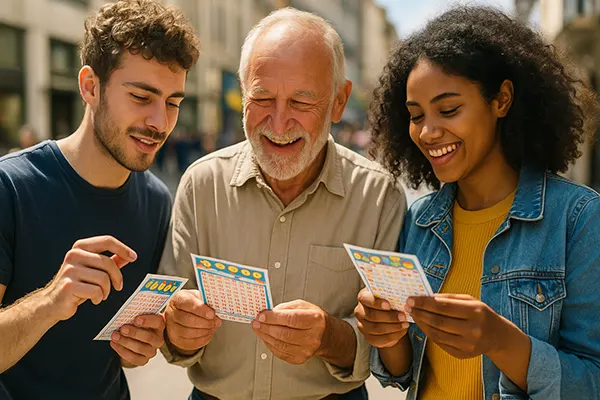
The Impact of Changing Demographics and Generations on Lottery Interest: What Statistics Show
Lotteries have long been a part of entertainment and social tradition, offering the chance to transform a small investment into a major prize. Yet, in 2025, the demographic profile of lottery participants is shifting rapidly. Social change, technology, and evolving attitudes towards risk and money have reshaped who plays, how often, and why. Understanding these trends reveals not only the economic side of lotteries but also their cultural significance in a new generational context.
Generational Differences in Lottery Participation
Over the past decade, surveys across Europe and North America show that the average lottery player has grown older. Data from 2024 by YouGov and Statista indicate that players aged 45–65 represent over 55% of all regular ticket buyers, while participation among those under 30 has dropped below 20%. This shift suggests that the traditional appeal of lotteries resonates more with generations who associate them with social habits formed before the dominance of online entertainment.
Millennials and Generation Z, meanwhile, express lower interest in traditional lottery draws. Their preferences lean towards instant-win formats and digital games that offer faster results and more interactive engagement. As a result, many national lotteries have adapted by integrating mobile apps, e-wallet payments, and gamified ticket systems to maintain relevance among younger audiences.
Despite declining participation among younger demographics, experts note a rise in curiosity during large jackpot events. Short-term spikes in ticket sales during high-profile draws, such as EuroMillions or Powerball, show that young adults remain attracted to extraordinary prize opportunities but prefer occasional play rather than consistent weekly purchases.
Statistical Insights on Age and Play Frequency
According to the World Lottery Association’s 2025 market overview, the median age of frequent lottery participants has risen to 47 years globally. In countries like the UK and Germany, players aged 55+ account for more than 60% of annual ticket revenue. This trend mirrors broader demographic changes, including ageing populations and higher disposable income among older adults.
Conversely, in developing regions such as Southeast Asia and Latin America, participation among younger adults remains strong. In these areas, lotteries are often linked to community projects and public funding initiatives, which enhances their social acceptance. The difference highlights how cultural perception influences participation across generations.
Experts forecast that by 2030, digital transformation and new game formats will be crucial to maintaining lottery revenues. Without engaging younger cohorts through personalised experiences and transparent play mechanisms, traditional draws could face stagnation despite overall market stability.
Economic Factors Shaping Lottery Preferences
Economic stability plays a significant role in lottery participation. During periods of inflation or wage stagnation, studies show an increase in ticket sales among middle-aged and lower-income groups. The 2025 OECD report on consumer spending habits confirms that lotteries often act as a perceived low-cost escape during economic uncertainty, even though the odds of winning remain extremely low.
However, Generation Z demonstrates a more pragmatic approach to financial risk. Many prefer investing small sums in cryptocurrencies or savings apps rather than purchasing lottery tickets. This behaviour reflects a deeper awareness of personal finance and the availability of alternative investment tools, which were not accessible to previous generations.
At the same time, higher-income professionals show growing interest in charitable lotteries and cause-based draws. These options combine the excitement of chance with social contribution, appealing particularly to ethically conscious Millennials who value purpose alongside entertainment.
Data on Spending Patterns and Motivation
Global gambling expenditure data from H2 Gambling Capital reveals that lottery spending accounts for around 26% of all gambling revenue in 2025, slightly down from 30% five years earlier. The decline correlates with the rise of online sports betting and instant-win platforms, which attract younger audiences.
In the UK, the National Lottery reports average monthly spending of £11.80 per adult participant, compared to £14.50 in 2018. Interestingly, 70% of players claim their motivation is not wealth but “entertainment and habit.” This demonstrates a psychological attachment to the ritual of play rather than pure financial expectation.
Meanwhile, digital engagement has diversified the player base. Mobile users now represent over 45% of all lottery purchases, suggesting that convenience remains a key factor in sustaining consumer interest despite broader demographic shifts.

Social Trends and the Future of Lotteries
Modern social values strongly influence how people perceive lotteries. Younger generations are more likely to question fairness, transparency, and ethical implications. As public trust becomes vital to long-term sustainability, national operators invest in responsible gaming campaigns and open-data systems to display where funds are allocated.
Social media also plays an essential role in shaping attitudes. Viral jackpot stories and influencer collaborations have revived temporary excitement among digital-native audiences. Yet, critics argue that such marketing cannot replace the community-based connection that older generations associate with physical lottery draws.
In 2025, analysts expect hybrid models to dominate the market—combining traditional draws with app-based experiences and social gamification. These innovations aim to blend nostalgia with digital comfort, ensuring that the lottery remains a relevant and trusted form of entertainment across generations.
Forecast and Adaptation Strategies
The future of lotteries depends on adaptability. Operators that recognise generational expectations and integrate modern technology while preserving credibility will likely thrive. Data analytics and personalised engagement are expected to become standard tools for player retention.
Moreover, the integration of blockchain for transparency and digital ID verification systems will reinforce consumer trust. This is particularly crucial for Generation Z, who value authenticity and security in all financial interactions. Publicly auditable systems could redefine how people perceive fairness in draws.
Ultimately, the success of the lottery industry lies in balancing tradition with innovation. While older generations maintain loyalty through habit and nostalgia, younger players demand interactivity and social meaning. Bridging these worlds may well determine whether lotteries remain a global pastime or a nostalgic relic of the past.
